|
NORTH EAST MARGAREE
Some things can be
described with ease, some more with an effort, others with great
difficulty, and still others not at all. A description of the old district
of North East Margaree, as it looks and stands at present, may quite
possibly fall within the last mentioned category. The district is large in
area, and such portions of it as are habitable are very densely peopled.
The major part of it consists of a valley fifteen miles long, lying
between walls of mountains some of which rise to enormous altitudes. All
these mountains are richly wood-clad. In summer the scenic features of the
surroundings are truly grand in their varied beauty and majesty. To essay
a pen-picture of that prospect were to spoil it. It must be seen to be
sensed.
There is a brimming river
running through the entire length of the settlement, gathering vigor and
volume from numerous babbling brooks that come rippling down the mountains
on either side. The main original Highway is quite close to the river on
the western side and is a delightful road to travel on. It is shaded in
summer and sheltered in winter; and always in good, safe condition.
The floor of the valley is
clear, level and spacious, and consists nearly all of meadow land. It is
not naturally so rich and productive as "the fair broad meads" of the
Forks, but it is capable of being made fertile and fruitful. The people
here should never cease to thank the Giver of all good for the pleasant
places in which their lives have fallen.
One of the first things
that will strike a stranger passing through here is the neat, attractive,
character of the people's abodes. The barns are large, comfortable, and
well designed; the dwellings in many cases are quite handsome, indicating
a good deal of architectural skill and taste. The farms, gardens and
orchards, are well kept and cared for. The public halls and school
buildings are modern and appropriate. Everything seems to suggest a fine
order of Comunal intelligence and industry.
There are four churches in
the district—Congregational, Baptist, Presbyterian and Catholic. The first
to be erected was the Congregational, built in 1822. Rev. Frank Darien, of
Manchester helped much to organize this church. We do not know the date of
the erection of the Baptist and Presbyterian churches. The Catholic church
was built in 1842; the site of it was deeded by Braziel Ryan and his wife
Jean Rods to Miles MacDaniel, Paddy Ryan, James Doyle, Nicholas Thumpkin,
Walter Fortune and Patrick Downey, Elders. Some more glebe land was
afterwards given by Moses MacDaniel. The first resident Priest here was
Rev. Eugene O'Riley, who came here from Pictou in 1858, and died in 1859.
Since then no priest was stationed here, the North East Church having been
served by the successive priests of East Margaree.
The old Justices of the
Peace within this district were Irad Hart and Hezekiah Ingraham both
appointed in 1827. Later appointees were Miles MacDaniel, Joseph A.
Ingraham, Thomas Ethridge, Murdoch A. Ross, and Malcolm MacLeod.
Some of the old-time
teachers here were the following, namely: Benjamin B. Etter, James Ayer,
John Munro, Mr. Jordan, Mr. Burke, John H. MacLeod, James Doyle, John C.
Munro, John A. MacDonald, A. G. Carmichael and Miles Tompkins.
From the earliest days the
pioneer settlers here appear to have been solicitors about the education
of their children. We append a correct copy of a letter addressed to their
first teacher by two of the leading settlers of that time, one a Catholic
the other a Protestant.
"Margaree, 2nd February,
1829. Mr. Benjamin B. Etter:
Sir:
We the subscribing Proprietors of the school taught by you in our
settlement have taught it our duty to write you these fue lines. In the
first case school hours from nine to three and from dark to nine untill
the tenth of March, then New Regulations for six months.
Second Case that all scholars taught by you
shall be teached their prayers once in twenty-four hours every one in
there own profession.
Thirdly that we shall look to you for the
proportion of house-rent, board lodging and fule for each and every person
that you shall take into the school whome is not a subscriber.
In haste we remain, Yours Truly,
Miles McDaniel. Edmund Ross.
In those days the men who employed a teacher
subscribed voluntarily for his remuneration "a pound per pupil for the
term." This explains the third clause of the above letter. There are some
infirmities of spelling in the above document, but its spirit displays
some lofty ideals which would well be imitated today.
The following are some of the recognized
merchants of this district since its early settlement; William Simpson
Hart, Thomas Eth-ridge, Martin Coady, Pierie Coady, John G. Crowdis, John
R. Ross, Isaac Murray, William Burton, Murdoch A. Ross; James Frizzle,
George P. Murray, John A. Ross, James Mariner Smith, Albert In-graham,
Alexander Fraser, Andrew Fraser and Ralph MacPherson.
The clergymen produced here were: Rev. Wm.
Burton (Baptist, Rev. Josiah Hart (Congl.), Rev. Malcolm MacDonald
(Baptist), Rev. Hugh Ross (Baptist), Rev. Alexander MacDonald (Baptist)
Rev. George MacPherson (Baptist), Rev. John H. MacDonald (Baptist), Rev.
John Marple (Baptist), Rev. L. Tingley (Baptist), Rev. James Tingley
(Baptist), Rev. Robert Ross, Rev. Edmund Crowdis, (Cong.), Rev. Charles
Crowdis (Pres.). The Catholic priests were: Rev. Michael Thompkins, P. P.
Guysboro; Rev. Moses McGarry,. Rev. Dr. H. J. Thompkins, St. F. X., Rev.
Dr. M. M. Coady, St. F. X.; Rev. Maurice Thompkins, P. P. Guysboro; Rev.
Miles N. Thompkins, (St. F. X.); Rev. Miles Keily (Boston); Rev. Dr. Frank
McGarry, (Boston); Rev. John McGarry (Boston); Most of these are still
living. The native
lawyers of this district were: the late John A. MacDonald Ex. M. P., of
North Sydney; Mattie Thompkins of Swift Current, and Henry T. Ross, at one
time Asst. Deputy Minister of Finance Ottawa, and Coady now of Vancouver.
We have said that this district is drained
from end to end by a fine river. It is to be added that this river is
teaming (in the summer months) with a variety of the best food fish.
Salmon, alecoives and trout, come up from the sea in large quantities into
this river every spring. It goes without saying that this is a great boon
for the inhabitants adjacent to the river. It is expedient that there
should be laws, and there are laws, for the regulation and protection of
these fisheries. There is also a large and costly staff of officials to
carry out and enforce these laws. There should not be much need of such
laws and officials in a civilized land, and among honest and resasonable
people. The early settlers had their own way—and, we think, a much better
and cheaper way—of dealing with these matters. We subjoin a copy of the
Minutes of a meeting held here by the freeholders of Margaree in 1813 in
relation to these fisheries:
"Proceedings of a meeting held by the
Inhabitants of Margaree Island of Cape Breton, on the first Monday of
February One Thousand Eight Hundred and Thirteen. According to an
ordinance passed in Council the thiry-third year of His Majesty's Reign,
and in the year of Our Lord One Thousand Seven Hundred and Ninety-three.
Voted.
1. That Ranald MacKinnon, Esq., shall be the
chairman of this meeting.
2. That Miles MacDaniel shall be Clark for this meeting.
3. That the Salmon Births shall be laid off by the overseers and a fair
lot drawn for the Births.
4. That 10th day of next May, providing the weather permits, the salmon
Births shall be laid out and drawn for.
5. That there is no nets more than thirty fathoms long shall be sot in
this River this present year.
6. That the distance between each net shall be Fifty Fathoms.
7. That no seen shall be set or hauled in the river of Margaree this year.
8. That the boundary of last year shall serve for the present year, and
that no net shall be sot below that same boundary inside the mouth of the
River this year.
9. That every man as soon as he has filled his fishing craft, he shall
leave his Birth vacant for another, at the Forks of this River at the
Alewives Fishery.
10. That the quibs of all fish dressed at the Forks shall be carried of
and Buried a distance from the Fork.
No need of red-tape law and officials here.
The people themselves in formal meeting assembled, had spoken and voted.
They meant to carry out, and did carry out, the things for which they
voted unaided by writs or constables. Any man who went back on his vote at
that meeting could never again look at his own face in the crystal waters
of that River. Such was the sterling honor of the pioneer settlers.
Yes; the minutes of that meeting were held
sacred as the Bond and Statute of that community; and quite correctly so.
No statute on earth can be more binding and effective, or more entitled to
respect, than those obligations, covenants and conventions, subscribed and
assented to by free intelligent men,in amity and good faith. We have
nothing but the highest respect for state law: but state law is made for
man, and by man. An honest man is a much bigger thing than any legislative
enactment. In the sense that "the boy is the father of the man", so "the
man is the father of the legislature." What gives value and virtue to
every state law is the public sentiment behind it. Long live our good,
old, home-made statutes!
THE PIONEER ROSS FAMILY.
In the last quarter of the 18th century four
unmarried Ross brothers came, with other Scottish emigrants from Scotland
to America. The names of these brothers were James, William, David and
Edmund. Naturally, they wished to be and remain near unto each other in
this new world of wilderness. Finding no suitable place to locate on in
Nova Scotia proper, they moved eastwardly into the Island of Cape Breton.
They first visited and examined the Southern and Southeastern sections of
the Island coast, but fell upon no place that appealed to them for a
settlement side by side. Then they proceeded Northwardly to a place now
called ''The Little Narrows." Here they tarried for a time; but did not
yet feel that they had found the place they wanted.
In the summer of 1800 the brother James Ross
set out from the Little Narrows, with an Indian guide, to explore the more
northern lands of Cape Breton. At that time it was a tense and tedious
track from the Little Narrows to the lower part of the river of North East
Margaree. Mr. Ross knew nothing of the country; the Indian was as familiar
with it as were the roving moose and caribou. After a tiresome journey the
redman conducted his white charge to the summit of a high mountain, and,
with a theatrical gesture, pointed out to him the promised land, "The
North East of Margaree," exclaiming in broken English,—"Dat place best in
worl" for paleface good man?" Mr. Ross was impressed. The following summer
he came and blazed out a future home and farm for himself. One year later
his three brothers above named came and settled by his side.
the four brothers together appropriating unto
themselves 2200 acres of superior land. This was the nucleus of
colonization in the noble valley of North East Margaree.
It may be worthy of mention that those four
brothers took unto themselves four wives of four different nationalities.
James' wife was French; William's Scotch; David's Irish and Edmund's
Dutch. The numerous descendants of those Ross pioneers thus represent, not
one but several noble races.
The wife of James Ross was a French lady by
the name of Harriet Le Jeune. She was the first white woman that came to
North East Margaree. She was married three times. At the time of her first
marriage in France she was but thirteen years of age. By that marriage she
had one child named Eusebe. Shortly after this event her husband was
drowned. She was married a second time, without issue, to a Captain Briand
who was killed in the second seige of Louisburg in 1758. This was shortly
after their marriage. She subsequently married James Ross, with issue:
James, Mary Barbara, Joseph and Jean. The first two named died in infancy.
Joseph settled down on the 400 acre farm formerly owned by his father.
Jean married Brazeil Ryan: subsequently she and her husband moved away to
Grand River, Codroy, Newfoundland.
The memory of Mrs. James Ross will always be
honored in this district. She was an ardent Catholic, her husband an
equally ardent Protestant; but they lived a happy, useful, peaceful wedded
life. She was an admirable helpmeet "but and ben", and was kindly and
charitably disposed. Her willing ministrations to her sick and suffering
neighbors will never be forgotten. She was brave, also, and would not
always run away from difficulty and danger. She brought her own musket
from Louisburg, and could shoot an evil-eyed bear with deadly presence of
mind and precision. She died at her home at the Northeast in May 1860, one
hundred and two years after the death of her second husband! Her mortal
remains lie buried in the Catholic cemetery overlooking her long loved
home at Margaree. She made several trips across the Atlantic before the
fall of Louisburg. Some years after her marriage to Mr. Ross she went back
to France to see her parents. On arriving there she found that her mother
had died, whereupon she brought her father, Dionne La Jeune, back with her
to the North East, where he remained till his death in 1825. Her last
husband, James Ross, also, attained to a ripe age, and was buried on his
own farm where a stately apple tree, well attended and preserved, marks
his last earthly place of rest. His fine old farm is now owned and
occupied by his great-grandson Thomas E. Roes.
William (one of the four pioneer settlers) was
married to Esther Moore with issue: John, William Donald, Jennie, Esther
and Mary. This William sold his farm to Miles MacDaniel, and moved with
his family to Washabuck in the County of Victoria. His son John was
married to Mary MacLean of Washabuck and had a large family. The second
son, William, was never married, went out to the Pacific Coast where he
worked as shipwright, and died. Donald (son of William Sr.,) was married
and had a large family. The daughter Jennie was married to Finlay MacRae
of Middle River and had a family. Esther was married to David Cormier of
Margaree, had a large family with whom she and her husband moved to Codroy,
Newfoundland. Mary, daughter of Wm., Sr., was married to a Mr. MacLeod of
Middle River. SCHEDULE
OF SOME ROSS FAMILIES.
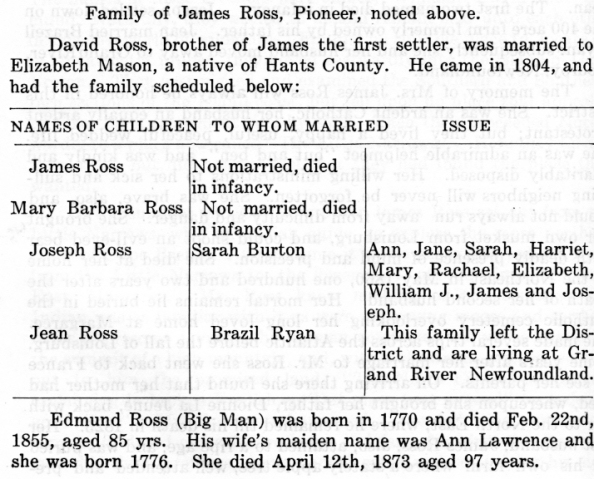
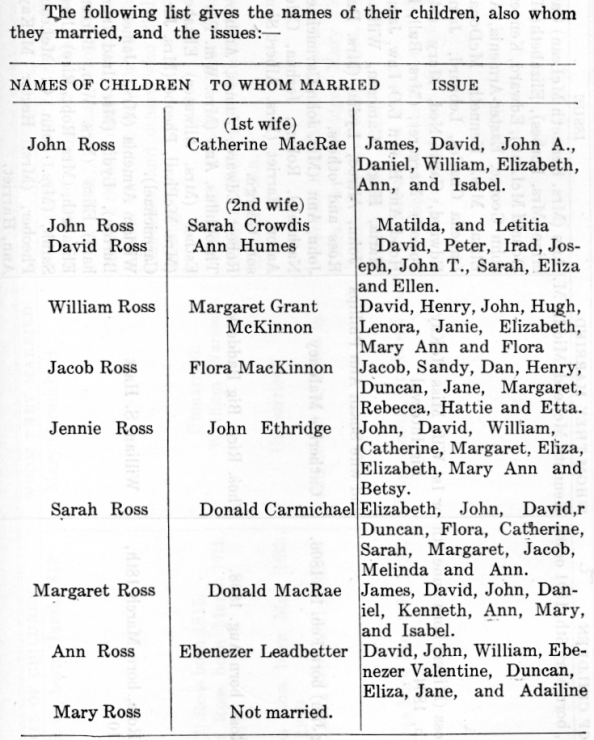
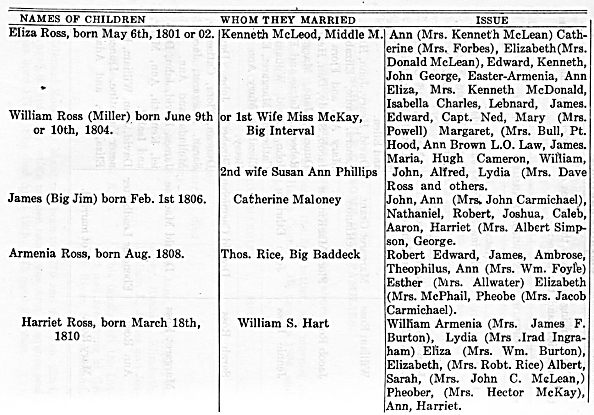
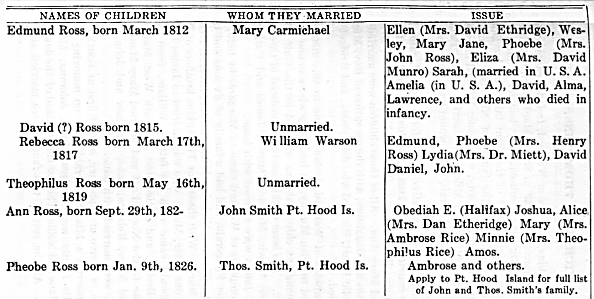
NICHOLAS THOMPKINS.
Nicholas Thompkins, a native of Wexford,
Ireland, came to Margaree in 1829, was married in 1832 to Sarah MacDaniel,
daughter of Miles, settled first at Big Brook, subsequently bought a farm
from Henry MacKinnon, being a part of the farm taken up by Donald Mowat
about the year 1804. The family of Nicholas Thompkins were: Mary married
to Pierre Coady, with issue: Michael married to Marcella MacLellan, with
issue: Miles, not married; John, Patrick, Rebecca, Nicholas, David and
Sarah, all of whom were married and had each a large family.
Patrick Thompkins, also a native of Wexford,
Ireland, came here in 1829, and was married to Mrs. Dunn, a widow, and had
the following family, namely: Rev. Michael, Richard, Nancy, Nellie,
Bridget John, Patrick and Mary Ann. All of these children were married and
had families of sons and daughters, with the exception of Rev. Michael who
was a Catholic Priest, Richard who died young, and Bridget who was never
married. James
Thompkins of Wexford, Ireland came to this district in 1829, was married
to Ellen Murray, an Irish lady who was one of five saved from an emigrant
ship that was wrecked in the Gulf of St. Lawrence in 1832. The issue of
this marriage consisted of three sons and one daughter, to wit, Michael,
Patrick, James and Catherine, all of whom but James were married with
issue. Michael
Thompkins of Wexford came to Margaree in 1829, was married to Bridget
Fitzgerald, and had a family of six sons and three daughters, namely:
Thomas, Nicholas, Michael, Jane, Bridget, Dennis, Peter, John and Mary.
With these four Thompkins brothers of Wexford, there came one sister,
Mary, who was married to James Brown. Maurice Fitzgerald came with his
father, William, from Nova Scotia to Cape Breton, and settled first at
South West Margaree. Later on He came to the North East and married Mary
MacDaniel by whom he had Miles, Rebecca, Jane, Matthew and John, all of
whom but John, were married with issue.
James Dunn, a native of Tipperary, settled
first at South West Margaree, and married a Miss Fitzgerald, later on
removing to the North East. His family were Andrew, John, Johanna,
Maurice, Michael, Mary, Jane and Nellie. The last three named of the
daughters remained single. All the rest of this family were married and
had large families.
John Nolan was married to a Miss Fitzgerald and had James, Michael, Moses,
Matthew, Ann and Johanna.
Michael Coady, was born in Miramachi, N. B.,
married Mary McDaniel, widow of Maurice Fitzgerald, and had James, Martin,
Mary Ann, Margaret, Ellen and Peter. Margaret and Peter lived a single
life. All the rest were married with families.
Philip Brown, born at Silver Springs, Co.,
Wexford, Ireland, came to Margaree about the year 1815, and married Mary
Le Jeune, niece of Mrs. James Ross elsewhere noted, and had Viney, John,
Margaret (living still at the age of 99), Joseph, James, Mary Ann and
Patrick. All of these except Viney and John (who left home young and was
never heard of since) were married and had sons and daughters.
Patrick O'Connor, born in Tipperary, came to
Margaree in 1820. He deserted from a man-of-war at Halifax, walked through
the woods to Mulgrave, swam the Strait of Canso with all his clothes tied
in a bundle around his neck, and finally pulled up at Margaree. He was
married to Isabel Marple and had Margaret, James, John, Mary, Michael,
William, Patrick, Isabel, Sarah and Ann.
Michael Murphy was born in Wexford, Ireland,
landed first at Newfoundland, was married at River Head, Harbor Grace in
1808 to Sarah Pennell, lived a few years in Antagonise, and came to
Margaree Harbor in 1812, and took up a farm and settled at Lake O'Law in
1821. Moses Murphy now lives on that farm. The family of Michael Murphy
and Sarah Pennell were, James who was married to Ann Doyle; Margaret to
James Doyle; Bridget married to Patrick Burns; John married to Esther
Ross; and Nellie to Mike Nolan. All had large families.
Patrick Ryan came from Tipperary to Lake O'Law
in 1824. He was married and has the following family; John married to
Elizabeth Ross; Johanna married to James Fortune; Mary married to Patrick
Wall; William to Ann King; Patrick, Philip and Margaret unmarried.
John Fleming born in Carrick, came first to
Newfoundland, then to Prince Edward Island, and later on to Lake O' Law in
1822. He returned to Newfoundland in 1827 where he married Margaret Byrnes
a native of Kerry. He and his wife came back to Lake O'Law in 1828. Their
family were Nellie married to John MacNeil; Thomas who left home when
quite young and was heard of afterwards; Bridget married to Michael
Murphy; and Dennis married to Flora MacNeil.
Thomas Coakley, a native of Ireland, came to
Lake O'Law in 1828 Was married to Ann Doyle and had the following family,
namely: Catherine, James (who was killed in the American Civil War),
Martin, (who shared the fate of James), John, Margaret (married to Michael
Murphy without issue) Annie who died young; Bridget unmarried; Thomas
married to Sarah Miller and had ten children, Moses (married) and Miles
who died in early manhood.
William Leahy was born in Cork and married to
Mary Downy. He came to Lake O'Law in 1829 and took up a farm. This farm he
afterwards sold to Justin McCarthy, and moved away with his family to
Halifax. The family consisted of six sons and five daughters.
James Doyle came from Wexford to Lake O'Law in
1830. He was married to a Miss Doyle, sister of "Mogue" Doyle, and had
three children, namely: John, married to Mary McCarthy; Ann, married to
Thomas Coakley; and Mary, married to Dennis McGarry.
James Fortune, a Wexford man, came to Lake
O'Law in 1830 and was married to Johanna Ryan. His family were Thomas,
Joseph Judith, Bridget, Patrick, James, Sarah, William, Walter, Mary and
Moses.
Harry McDaniel was married in Wexford to Ann Cameron, and came to Margaree
in 1830, settling at Lake O'Law. His family were Mathew, Miles, James,
Mary, Sarah and Margaret.
Dennis McGarry, a native of Dublin came to
Lake O'Law in 1831 and married Mary Doyle. (See sketch of Forks.) He had a
family, six sons and four daughters, to wit: Bridget (not married); James
(married to Nancy Thompkins); Charles (married to Miss Petipas); Mathew;
Dennis (father of Rev. Frank and Rev. John); Margaret ( married to John
Kiley); Catherine (married to Peter Thompkins); Mary (married to a
MacLean); John (not married); and Reverend Moses.
Walter Fortune was a native of Wexford and
came to Lake O'Law in 1831. He was married to Elizabeth Moran of Port
Hood, and had Mary, Bridget, Catherine, Thomas, Walter, John, Patrick,
Joseph, James and Peter.
Patrick Downey came to Lake O'Law from Mabou,
and had the following family: James, Michael, Patrick, Thomas, Mary,
Bridget, Elizabeth and Kitty Ann. This family moved to Codroy,
Newfoundland, where their descendants still are.
James Miller came to Margaree from Nova Scotia
in 1840, was married to Jane Marple, and had Richard, Joseph (father of
Dr. Alex. Miller), Margaret (married to Archd. MacKinnon),and Sarah
(married to Thomas Oakley.)
Miles McDaniel one of the first settlers N. E.
Margaree was born in the County of Wexford Ireland in the year 1788 landed
at St. John's Newfoundland 1807 married at Port Hood Island Sept. 17-1811
to Rebecca Smith only daughter Capt. David Smith she was born at "Cape
Cod" Mass., U. S. A., 1787 came to Port Hood Island 1794 died at North
East Margaree, Feb. 28th, 1864.
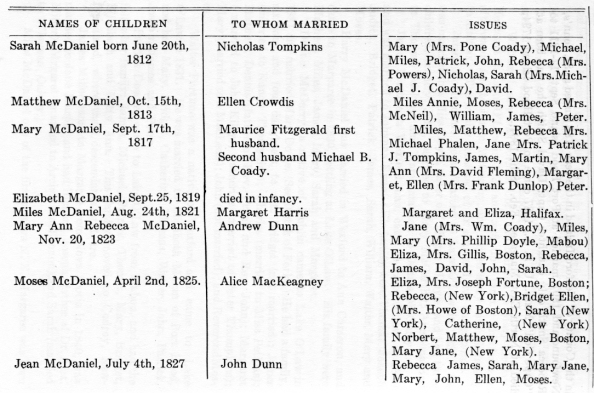

These Irish of the Margarees have proved
themselves an exemplary body of men and citizens. They have certainly been
a valued asset for the county of Inverness. Here they have always been the
firmest friends of law, order, industry and sane ambition. Like nearly all
our pioneer workers, they were forced to come into these virgin wilds with
nothing but their willing hands and a strong faith, and have become a
recognized force in the moral and material progress of the country.
Time was when these Irish at home, like their
kinsmen, the Highland Scots, were the objects of scorn, persecution,
misrule and murder at the hands of proud power. The helpless Celts were
constrained to take their medicine lying down, and dumbly. Yes, that was
long ago. Things have changed and are changing. As an answer to the cruel,
mal-treatment of the Celts in their sireland, we need but to cite their
lives, labors and virtues in the county of Inverness.. Today humanity
shudders at "man's inhumanity to man." We knew it would come, we know it
is coming,—the awful answer to Markham's query in respect of "The man with
the hoe":— ''How will
it be when this dumb terror, shall Reply to God, after the silence of the
centuries?" THE
CROWDIS FAMILY. Mark
Crowdis came from Yorkshire, England, and settled at Baddeck. He had four
sons one of whom, John, came to N. E. Margaree about the year 1810 and was
married to Sarah Hart, eldest daughter of Irad Hart, the first Hart
settler in this District. The issue of that marriage consisted of the
following family, namely: John G. who was married with issue to Mary Jane
Sampson; Mark W., married to Mary Ross; Thomas R. married to Sarah Watson;
Irad, who died in infancy; Armenia married to John Barton; Pantha married
to Robert Burton; Ann married to Hugh Fraser; Sarah to John Ross; Eliza to
Henry Cranton; Lydia to Andrew Watson; and Isabella to Henry Watson. The
John G., of this family was doing mercantile business for many years at
Margaree Harbor. He was a large man of fine intelligence. He was one of
the old Justices of the Peace of Inverness County. After retiring from
business he built and conducted, with dignity and satisfaction, the large
Hotel at the Harbor.
THE CARMICHAEL FAMILY.
Daniel Carmichael was born at Oban, Scotland,
Oct. 17th, 1787. His wife was born Dec. 27th, 1797. He was the son of
Duncan Car-michael and his wife Flora Nicholson. In 1810 he emigrated to
America, presumably with other emigrants. In February they sighted Sydney,
C. B., but could not land owing to drift ice. Their ship kept cruising and
drifting along the Island coast until the following month of April, when
they were able to land at Ingonish. They suffered terrible hardships and
privations. For a long time they had neither food nor water. After landing
they had extreme difficulty in reaching a house where they found food,
drink and shelter. Out of the whole group only five survived the painful
ordeal. Daniel Carmichael was one of these five. The five survivors worked
their way to Baddeck, and Donald Carmichael took up a farm at Washabuck.
He married Sarah Ross, daughter of David, of North East Margaree. They
remained for some years at Washabuck where seven of their family were
born, namely: Mary, Elizabeth, John, David, Duncan, Flora and Catherine.
Then they removed to North East Margaree and secured a farm there on which
five more children were born to them, to wit: Sarah, Margaret, Jacob,
Melinda, and Annie.
Mary Carmichael was married to Edmund Ross and had nine children, named in
the description of Edmund Ross.
Elizabeth Carmichael was married to John
Ethridge, with issue: as stated elsewhere.
John Carmichael was married twice: 1st to
Sarah Ethridge, by whom he had Elizabeth, Mary, Thomas, Hattie and Sarah.
His second wife was Ann Ross by whom he had George, Margaret, Phoebe,
Hattie, Eliza and Aaron.
David Carmichael was married to Peggy
MacPherson with issue: Donald, Edward, Dr. Alex G. and Margaret.
Duncan Carmichael was married to Isabel
Ingraham with issue: John, Wesley, Elizabeth and Daneil.
Flora Carmichael was married to Joseph Tingley
and had Job, Melinda, Calvin, Sarah, Phoebe, Judson and George.
Catherine Carmichael was married to Donald
MacDonald with issue: Jane (Mrs. Jas. Frizzle), Francis, Annie, Mary, Rev.
Dr. John H., Havelock, George and Ella.
Sarah Carmichael was married to Kenneth
MacLeod, and had Margaret, Eliza, Alfred and John.
Margaret Carmichael was married to James J.
Ross, with issue: William, Jacob, Melinda, Hattie, Isaac, Sarah, Rachael
and James. Jacob
Carmichael was married to Phoebe Rice by whom he had the following family,
namely: Duncan, Thomas, George, Jacob, William, Edward, Minnie, Clara and
Nellie. Melinda
Carmichael was married to Ambrose Smith of Port Hood Island.
Jane was not married.
THE ROSS FAMILY OF BIG INTERVALE
Big Intervale is a magnificent section of the
North East District. It is further inland than the most of the district
and is somewhat hidden in ''a sea of mountains", one of which is the giant
"Sugar Loaf." For that reason, in all probability, it was not settled as
early as the area nearer to the ''Forks" and the sea. The natural scenery
here now is a marvel of boldness and beauty combined.
The first man to settle at Big Intervale was
Angus K. Ross of Kilmuir in the Isle of Skye, Scotland. He crossed the
ocean in a ship called "The Crown of Dumbarton." He landed at Canso whence
he proceeded to N. E. Margaree, and took up 200 acres of land at Big
Intervale. He was married before he emigrated to Catherine Mac-Arthur of
Kilmuir, by whom he had a family of four sons and four daughters. Three of
these children were born in Scotland, the remaining five at Big Intervale.
His son Murdoch A., born Sept. 22nd, 1832, and still living on the old
homestead, was the first white child ushered into the world at Big
Intervale. Angus K.
Ross prospered at the Big Intervale, so much so that he became known as
"King Ross." All his sons and daughters were married and had families, but
the most of the younger folk are scattered over many of the cities and
towns of America. The
Indians were here in force, when King Ross came; so also, were the Moose
and the Caribou . The Moose is now practically extinct and but few
Caribou, are seen; but, strangely enough, their place in the forest is
rapidly being taken by the Red Deer.
THE MACKENZIE FAMILY.
Kenneth MacKenzie (Maclain ic Rusridh) came
from a place in Scotland called Apple Cross, Comrick, Rossshire, and
settled at Middle River in the county of Victoria. He had four sons and
five daughters. The
sons were John, Kenneth, Roderick Senior and Roderick Junior. Roderick
Senior married Johanna MacLean of Druim a chorka, Poolewe, Gairloch,
Scotland. Poolewe took its name from the fact that a certain much missed
ewe was drowned in the pool. This Roderick, with his family of three boys
and four girls, moved from Middle River to Big Intervale about the year
1832, and took up 200 acres of land there. He was the progenitor of the
MacKenzies of the North East. His wife, Johanna MacLean, came from
Scotland in a ship called "The Six Sisters" and landed at Bras D'or. She
had the distinction of being, on her mother's side, a direct descendant of
Rob Roy MacGregor. THE
MACDONALD FAMILY.
John MacDonald from the Isle of Skye came to the North East of Margaree in
1828, and settled down on a large farm. He was married twice in Scotland,
first to a Miss Gordon by whom he had one son John; and next to Catherine
MacLeod of Skye by whom he had Lauchlin, Donald, Murdoch, Rev. Alexander,
and Flora. All of these children were born in the Isle of Skye.
The son Lauchlin was a notably worthy and
intelligent man. He was married to Margaret Matheson by whom he had the
following family, namely: Jessie (Mrs. Wm. E. Hart); Flora (Mrs. Edward
Irish); Catherine (Mrs. Joseph P. Burton); Donald;John A. (Barrister);
Alexander; Margaret (Mrs. Charles MacPhee) Duncan H., Mary, Femmie (Mrs.
Alexander MacLean); and Christina (married first to James G. Dunlop, and
afterwards to Dr. MacDonald of St. Peters). The sons John A., and Duncan
H., are men of special intelluctual gifts.
Donald was married to Catherine Carmichael and
had Jane (Mrs. Jas. Frizzle); Francis, Mary Steel, Annie, Rev. Dr. John
H., Havelock, George and Ellen.
Murdoch was married to Mary Ingraham with
issue: Femmie (Mrs. Joseph F. Ross); Eliza, (Mrs. Joseph J. Ross) Mary
Jane (Mrs. Jas. G. McDonald); William, Alfred, James, Lydia, Alma (Mrs.
John MacDonald). Rev.
Alexander was married to Jennie Crawford and stationed for a while in
Prince Edward Island. He removed thence to South Hampton, N. B., where he
died. Flora was never
married.
THE ETHRIDGE FAMILY.
In 1794 Thomas Ethridge came to Margaree from
St. John's, Newfoundland, with skipper Robert Cranton. Later on he married
the widow of skipper Cranton by whom he had the following family, namely:
John and Thomas. John
Ethridge was married to Jennie Ross with issue: John, David William,
Elizabeth, Sarah, Mary Ann, Catherine, Margaret and Rebecca.
The son Thomas was married to Elizabeth MacRae
and had William, Donald, Thomas, Jane, Sarah, Euphemia, Bella, Elizabeth
and Mary Ann. The family of this Thomas were married as follows: William
to Ann Henderson; Donald to Ann Ross; Thomas to Harriet Ross, Jane to
Duncan MacDonald; Sarah to John Carmichael; Euphemia to John Campbell;
Bella to Alexander MacDonald; Elizabeth not married; Mary Ann married to
Fred Cranton. The
Ethridge farms were fine properties, and were well developed and cared
for. Not many farms in Cape Breton produced more beef cattle of a high
grade than did the farm of our old quondam friend, Donald Ethridge, one of
the earliest Municipal Councillors for the County of Inverness.
IRAD HART
Irad Hart, the first Hart settler in Margaree
was the son of Josiah Hart. His mother's name was Lydia Moss, and both his
father and mother came from Hartford, Conn., U. S. A., to Manchester, N.
S., where their first children were born. Irad Hart married Armenia
Ingraham daughter of Hesekiah. She was born in the year 1778 and Irad Hart
her husband on Jan. 2th 1771.
The following are the names of their children
also whom they married, and the issues:
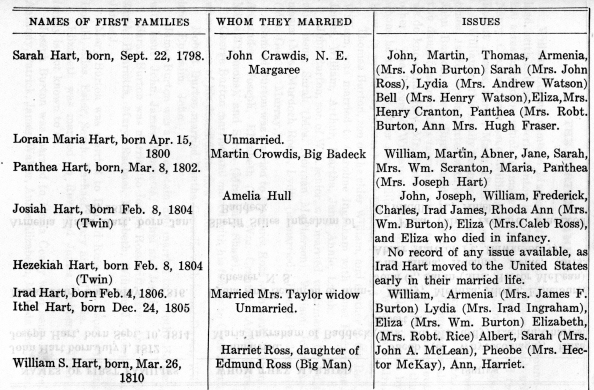
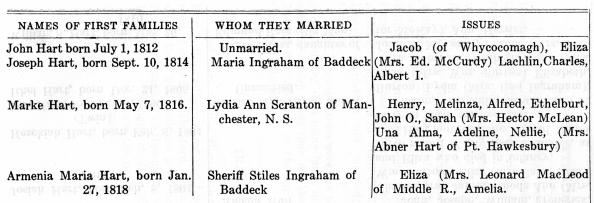
THE BURTON FAMILY
William Burton came to Margaree from St.
John's, Newfoundland, with skipper Robert Cranton in 1794, and afterwards
took up 200 acres of land on which he made his home. He was married to
Nancy Cranton, with issue: William, Thomas; John, Samuel, George, Robert
James, Sarah, Mary, Elizabeth and Joseph.
William of this family became a clergymen and
was married three i times; 1st to Sophia Cutten with issue four sons,
Captain Joe Burton, John Burton, David Burton and James Burton. There were
also two daughters from this marriage whose names we do not know, but we
do know that Rev. Mr. Stubbert married one, and Mr. Eustis the other. The
Reverend William's second wife was Laleah Holmes by whom he had one other
son, William. His third wife was a Mrs-Davis (a widow) by whom he had
Edward, Floe and Sophia.
Thomas Burton, son of the elder William, and
brother to the Rev. William, was married to Caroline Ingraham with issue:
Richardson, James, William, Arthur, Martha, Jane, Annie, Laliah.
John Burton, son of Wm. senior, was married to
Armenia Crowdis with issue: Sarah (Mrs. Norman McPherson), William, John,
Armenia (Mrs. Murdoch Ross), Lydia (unmarried), Joseph P., Melinda (Mrs.
Geo. P. Murray.)
Samuel Burton was married to Margaret Ross with issue: William,.
Alexander, Joseph, Elizabeth (Mrs. Wm. Cranton), Annie (Mrs. Miles
Timmons), and Sarah (Mrs. Sam Shaw).
George Burton married and moved with his
family to Cape North where some of his descendants now reside.
Robert Burton married Pantha Crowdis with
issue: David, William, Ephraim, John.
James Burton was a sea captain, and married to
Dorothy Holmes,. with issue: John, James, Henrietta, Sophia and Jennie.
Sarah Burton was married to Joseph Ross with
issue: Ann, Jane, Sarah, Henrietta, Mary, Rachael, Elizabeth, William J.,
Joseph J., James J.
Mary Burton was married to Donald Ross with issue: William, Donald, Silas,
Ester, Sarah, Rachael, Mary and Matilda.
Elizabeth was married to Reverend James
Stubbert. Their family is not known to us.
Joseph Burton was married to Maria Coady with
issue: George,. Anthony, Patrick, James, Walter, Annie, Elizabeth, Matilda
and Helen. THE MUNRO
FAMILY John Munro
Esquire came from Inverness, Scotland, about the year 1835 and settled
down at North East Margaree. He taught school for several years at the
North East. He was the first teacher in the first school house erected
here in 1835. Benjamin Etter and others taught here previously, but in the
farmer's houses; they had no school house. Mr. Munro was a Coroner in and
for this district. He was married and had the following family, namely:
Mary Ann, Patrick, David, John C, George, James, Andrew and Minnie.
Mary Ann was married to Joseph Lewis with
issue: Amelia, John, James, William, George, Alfred, Andrew, Hugh and
Armenia. Patrick was
married first to Elizabeth Ethridge and had David, who married Flora
Fraser, John P., who married Nina MacLean, and George. His second wife was
Elizabeth Philips by whom he had one other son named George.
David was married to Eliza Ross with issue:
Bertha (Mrs. Thompson), Gertie, Alcorn (who married Miss MacKenzie), James
(married Miss MacKay), Addie (a trained nurse) and Stanley (killed in the
Great war). John C.
was married to Matilda Ross with issue: Laura (Mrs. De Gruchy), Eva (Mrs.
Chas. Herman), Ernest (married to Miss Cooper), Fred (married to Miss
Austen)Arthur (married to Miss MacKay) and Olga (Mrs. Hillis). This John
C. Munro, who does business at Margaree Harbor, has been one of the most
successful merchants of Inverness County.
George Munro was married to Mary Ross with
issue: Hanlan (married to Miss McKay), Lellia and Dr. Japtha.
James Munro was married to Melinda Ross with
issue: Everett (in Boston), Mina (Mrs. MacLean of Truro).
Andrew Munro was married to Laura Hart with
issue: Isabel, Hart, Maria, Kathleen, Janet, Alice, George, James, John,
Mary Ann and Minnie.
Minnie Munro was married to Dr. Allen MacLean, a native of Whale Cove, who
practised his profession and died at West Bay, with issue: two sons,
Gordon and Munro. THE
PHILLIPS FAMILY John
Phillips was an Englishman. He came from England to Newfoundland where he
stayed for some time. In 1794 he came from Newfoundland to Margaree Harbor
in a vessel owned by Captain Robert Cranton. A few years later he came to
the North East where he permanently settled down. It may be worth telling
that when John Phillips crossed from Newfoundland to Cape Breton, Sarah
Cranton, daughter of Captain Robert Cranton, was in the same boat with
him. Before then neither of them ever heard of the other. Shortly
afterwards this same Sarah Cranton became the first wife of John Phillips.
Man will find a way to meet his fate.
The family of John Phillips by Sarah Cranton
were: John Jr., Henry, David, Stephen, Susan Ann, Ann and Sarah.
John Jr., was married to Lucy Rice with issue:
John, Timothy, Robert, Stephen, Maria (Mrs. Barrett of Jersey), Sally
(Mrs. Spencer), Catherine, Emilia and Ellen.
Henry was married to Ann Rice with issue:
Catherine, Lydia (Mrs. Wm. Burton), Armenia (Mrs. John Ingraham), Ann
(Mrs. Cross), William married to Sarah Woodburn, Thomas to Melinda
Ingraham, James to Catherine Ethridge, Robert drowned.
David was married to Sarah Weybrant and had
David, Armenia, Reuben, John T., Wm H., Lorine, Jacob, Delina, Joseph and
Harriet. Stephen
Phillip, son of John Senior, was married to Ann Cranton, and had the
following family: William, Cassie, John, Jemima, Kesiah, Sarah, Jeremiah
and David. Susan Ann
was married to Wm. Ross (miller) and had the following family: Mary, Ann,
Armenia, Capt. Ned, Margaret, Maria, William, John, Rupert, James, Lydia,
Alfred and Sarah, All of the foregoing came by the first marriage of John
Phillips to Sarah Cranton.
He was married a second time to Harriet
Ingraham with issue: Ester, Samuel, Reuben, Benjamin, Charles and James.
All of these were married and had large families, except James.
Ester was married to Thomas Shaw and had five
sons and two daughters.
Samuel was married to Ellen Shaw with issue:
four sons and three daughters.
Reuben was married to Ann Waybrant and had
five sons and four daughters.
Benjamin was married to Mary Ann Wilson with
five sons and four daughters.
Charles was married to Mary Ann Ethridge with
issue: five sons and three daughters.
James was married to Emiline Wilson without
issue. Murdoch Ross,
School Teacher; in Scotland with his wife, Isabella MacDonald came from
the Parish of "Kilmuir" Isle of Skye in the year 1828, and took up 200
acres land at what is now known "The Sugar Loaf". His family was born in
"Skye", five sons and two daughters. Hugh and Malcolm did not stay long,
they were both Baptist Ministers, but the former left the ministry after a
time. He married Catherine Beaton and Malcolm married Elizabeth Ellis and
died in P. E. Island. Hugh died at N. E. Margaree. The descendants of
Donald Murdoch and John Murdoch are still in the Valley but those of
Catherine who married Murdoch MacLean of Skye, are not living here. The
other sister Christy married John McLeod "Soldier" and the family have all
gone away. Malcolm
McLean of Isle Skye and wife Flora McArthur came to N. E. Margaree 1830.
Mrs. McLean died here aged 110. They had one son Murdoch McLean who
married Catherine Ross daughter Murdoch and Isabella Ross. She was killed
by a runaway horse Aug. 15th, 1873. They had three sons, John, Nehemiah,
Allen, and seven daughters, Ann, Mary, Catherine, Femmie, Isabella, Ellen
and Jessie. all left this district.
Malcolm McLeod ''Soldier" and wife Sally
Anderson from Paisley Scotland came here about 1830. They had three sons
Allen, John and Malcolm (Red), and two daughters Christy (Mrs. Michael
Cameron) and Catherine.
This Malcolm MacLeod (Red) has long been known
in the County of Inverness as a man and citizen of first rank. His
splendid Highland home at Big Intervale will always be remembered for its
comfort, kindness and hospitality. We regret that we have been unable to
secure a detailed history of both himself and his interesting family. But
Red Malcolm does not need to be embalmed in history. His name is carved
forever on the grateful hearts of his very numerous friends, guests and
callers. The first
Ingraham settler of N. E. Margaree was Hezekiah In-graham, son of Timothy
Ingraham of Hartford, Conn., U. S. A. This Timothy did not come to Nova
Scotia. Hezekiah had four sons and eight daughters as follows:

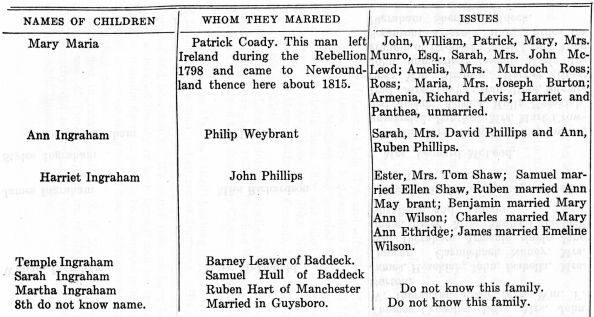
.
THE CRANTON FAMILY
Robert Cranton, a native of England, came in
his own vessel to Margaree Harbor about the year 1794. He appears to have
been trading for some years between Margaree Harbor and Newfoundland and
adjacent Islands before he located at the North East. In fact, after
taking up 200 acres of land at the North East he again went trading,
leaving Thomas Ethridge in charge of the farm. He was lost at sea. His
wife had one child shortly after he was drowned, and the child was called
after his father—Robert. Three daughters came to Margaree with Robert
Cranton Senior, and one remained in St. John's and was married there.
Robert Cranton Jr., was married in due time to
Catherine Rice with issue: Mary, William, Ann, Robert, John, David,
Frederick, Henry, Thomas and Sarah. This Robert J., was married a second
time to Christy MacLean without issue.
Mary, daughter of Robert Jr., by his first
marriage was married to Jeston Timmons, with issue: Patrick, Robert, John,
Ann and Sarah (Mrs. Jas. Phillips).
William was married to Sarah Phillips and
William and Euriah.
Ann was married to Stephen Phillips and the names of her family follow:
Wm. (who married Mrs. Ann Ethridge), Cassie (Mrs. Robt. Phillips), John,
Jemima (Mrs. Malcolm Dermid), Kesiah (Mrs. John McDermid) Sarah (Mrs.
Patrick Burton), Jeremiah (married to Isabel MacLean), David (married to
Bell Cranton). Robert
Cranton, son of Robt. Jr., was married to Jane Ross and had, Walter,
Arnold and Rose. John
Cranton was married to Ellen McColl and had John, Herbert, Alice (Mrs.
Edward Watson), Guilford, Emily (Mrs. Henry Ross) and Maude.
David Cranton was married to Christie Morrison
with issue: Calvin, Warren, Irad, Gordon, Betsy (Mrs. Fraser), Alexander
and John. Fred
Cranton was married to Mary Ann Ethridge and had: John A., Sarah, Isabel
(Mrs. David Phillips), Daniel and Elva.
Henry was married to Eliza Crowdis with issue:
Walter, Wilson, George, Catherine (Mrs. Alfred Hart), Rose, Eva and Agnes.
Thos. Cranton married Elizabeth Ross and had:
Margaret (Mrs. Ed. Cranton), Wallace and Kate.
Sarah Cranton was married to John T. Phillips
with issue: Emelia, Noah, Catherine (Mrs. Walter Cranton), Merriam (Mrs.
Ed. Ross), Isadore (Mrs. James Ross), John and William.
On the surface it would seem that others had
come into the settlement of North East Margaree before James Ross and his
brothers located there. The explanation given to us is this: John
Phillips, Robert Cranton, and others, came to Margaree in a vessel in
1794, or thereabouts. They landed at Margaree Harbor around which they
remained till James Ross and his brothers had discovered and occupied the
great valley of the North East. That is our information. and the consensus
of opinion in the district. There may be a possibility that James Ross and
his brothers came earlier than 1800. The fact that James' wife was at the
siege of Louisburg in 1785, where her second husband was killed, would
tend to support this hypothesis. There are no authentic records available
to prove those dates. We could only take the information given by the
families immediately concerned, and they are all intelligent and
respectable. |

